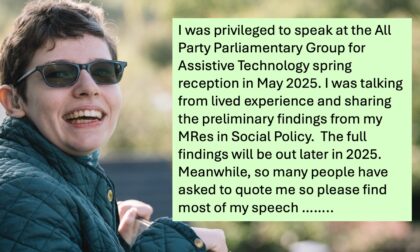Using AAC at home and in the wider community has to be a real goal in my mind. Schools are reactive environments for many children who use AAC, answering questions in the closed context of the lesson. Or maybe making functional choices at break times. By comparison outside school there is the wider context of family and community activities. This brings a greater opportunity for children to be proactive in their communication.
Early intervention when it’s right
I believe the earlier a child and their support network are introduced to AAC resources the better. My Mum openly shares how she rejected a communication board for me when I was nearly 3. She didn’t get the value of a board with 2 drinks offering me a choice of milk or orange when I could ask my way for a drink from a greater choice without prompts. Maybe it was the way it was introduced but she wasn’t buying it as right for me. Or, just maybe she wasn’t ready to recognise I would need extra support for communication outside the family.
Family can support functional communication
Fortunately, Mum did see the value of an electronic or high-tech device, and I was still 3 when I had my first assessment. At about the same time I had an Early Learning Centre computer which let me put in whole words and I was making short phrases. What we did at home throughout my life supported my functional communication. This ranged from a teenager coming in every day during school holidays to share playing on my device. Then there was always a focus on asking and answering open questions (think who, what, where, when, how and why). This meant giving full answers not just one-word answers or choices.
At home more than in school
My point, however, is that children are out of school much more than they are in it during their formative years. By my reckoning with school holidays, weekends, pre and post-school each day children are in school less than one-third of their waking lives. That means they are learning in an informal setting for two-thirds of their waking lives. Would it be unrealistic to suggest that at least as much specialist support should be put into the home environment as the formal school environment? Parents and family networks need training to be communication partners and to model good communication for others. Using AAC at home needs support. In addition, there is definitely a need for out-of-school access to support creating resources, troubleshooting tech issues and more.
A time and place for AAC
I do accept there has to be a time and a place for families to accept the need for using AAC at home. Everyone is unique and every family is different. None will have the same trajectory, and we must also remember a child with complex needs, and their family, will have many more demands on their time daily. In my experience physiotherapy and occupational therapy outside of school are often seen as more pressing and present than communication support.
You can read more about how I learned to use my device(s). This one is about building competence and confidence, and here’s a link to more about how I use AAC.





If you found this interesting or
helpful please feel free to share.